Gum 17
Also called
RCW 33Coordinates: (263.0°, 1.4°)
[ Catalog | Explorer | SIMBAD ]
There are at least two conflicting distance estimates - one is based on the assumption that this HII region is associated with the star cluster Trumpler 10 at about 400 pc, and the other that it is associated with HD 75759 at about 1000 pc.
You can see a good colour image of RCW 32 and RCW 33 together here, which is linked from Steven Lee's webpage.
You can see a good colour image of RCW 32 and RCW 33 together here, which is linked from Steven Lee's webpage.
Avedisova concludes that RCW 33 is ionised by the O9 V star HD 75759 (which she also lists as an ionising star for RCW 32) as well as the B0.5 V star HD 75724. [1] She places RCW 27, RCW 32, and RCW 33 together in the star formation region SFR 265.00-2.00 along with the Vela dark cloud complex described in this 1976 paper.
Kharchenko, on the other hand, places HD 75724 in Trumpler 10, for which she gives a distance estimate of 417 parsecs. She places HD 75759 in a more distant star cluster, Alessi 43 = [KPR2005] 50, at 850 parsecs.
You can see this large nebula in this SuperCOSMOS hydrogen-alpha image, which also shows the boundaries of Trumpler 10 and Alessi 43.
Probably ionised by the O9V star HD 75759 at a distance of about 1000 pc.[2]
Kharchenko, on the other hand, places HD 75724 in Trumpler 10, for which she gives a distance estimate of 417 parsecs. She places HD 75759 in a more distant star cluster, Alessi 43 = [KPR2005] 50, at 850 parsecs.
You can see this large nebula in this SuperCOSMOS hydrogen-alpha image, which also shows the boundaries of Trumpler 10 and Alessi 43.
Probably ionised by the O9V star HD 75759 at a distance of about 1000 pc.[2]
Notes
1. ^ Avedisova, V. S. & Kondratenko, G. I. (1984). "Exciting stars and the distances of the diffuse nebulae", Nauchnye Informatsii, Vol. 56, 59. [1984NInfo..56...59A]
2. ^ Pettersson, B. & Reipurth, B. (1994). "Young stars associated with the VELA Molecular Ridge. I. VMR clouds C and D, Collinder 197 and VELA R2", Astronomy and Astrophysics Supplement Series, Vol. 104, 233-258. [1994A&AS..104..233P]
Distance estimates
424 pc [2000AAS...197.1002K]1000 pc [1994A&AS..104..233P]
1070 pc +/- 230 [1984NInfo..56...59A]
Links
[ DSS | ADS | ADS Abstract ]
map | book | blog | gallery | sources

Most of the sources used to create these nebula descriptions are listed in the
notes section for each description. In some cases,
for example the Avedisova, Humphreys and Reed catalogs, the source is used extensively and is not listed in the
individual nebula descriptions. See this catalog overview
for more information on the catalogs and the general sources used
to create these descriptions and this introduction to HII regions
on the general history of this area of astronomy.
This image was created using the POSS-II/UKSTU data of the Digitized Sky Survey and SuperCOSMOS using the process described here.
According to my correspondence with the Royal Observatory Edinburgh and the Space Telescope Science Institute, I am allowed to use the POSS-II/UKSTU data to create and display images for non-commercial purposes so long as I include this fine print for the SuperCOSMOS data:
Use of these images is courtesy of the UK Schmidt Telescope (copyright in which is owned by the Particle Physics and Astronomy Research Council of the UK and the Anglo-Australian Telescope Board) and the Southern Sky Survey as created by the SuperCOSMOS measuring machine and are reproduced here with permission from the Royal Observatory Edinburgh.
and this acknowledgement taken from the DSS site:
The Digitized Sky Surveys were produced at the Space Telescope Science Institute under U.S. Government grant NAG W-2166. The images of these surveys are based on photographic data obtained using the Oschin Schmidt Telescope on Palomar Mountain and the UK Schmidt Telescope. The plates were processed into the present compressed digital form with the permission of these institutions.
The Second Palomar Observatory Sky Survey (POSS-II) was made by the California Institute of Technology with funds from the National Science Foundation, the National Geographic Society, the Sloan Foundation, the Samuel Oschin Foundation, and the Eastman Kodak Corporation.
The UK Schmidt Telescope was operated by the Royal Observatory Edinburgh, with funding from the UK Science and Engineering Research Council (later the UK Particle Physics and Astronomy Research Council), until 1988 June, and thereafter by the Anglo-Australian Observatory. The blue plates of the southern Sky Atlas and its Equatorial Extension (together known as the SERC-J), as well as the Equatorial Red (ER), and the Second Epoch [red] Survey (SES) were all taken with the UK Schmidt.
The "Second Epoch Survey" of the southern sky was made by the Anglo-Australian Observatory (AAO) with the UK Schmidt Telescope. Plates from this survey have been digitized and compressed by the ST ScI. The digitized images are copyright ? 1993-5 by the Anglo-Australian Observatory Board, and are distributed herein by agreement.
The "Equatorial Red Atlas" of the southern sky was made with the UK Schmidt Telescope. Plates from this survey have been digitized and compressed by the ST ScI. The digitized images are copyright ? 1992-5, jointly by the UK SERC/PPARC (Particle Physics and Astronomy Research Council, formerly Science and Engineering Research Council) and the Anglo-Australian Telescope Board, and are distributed herein by agreement.
The compressed files of the "Palomar Observatory - Space Telescope Science Institute Digital Sky Survey" of the northern sky, based on scans of the Second Palomar Sky Survey are copyright ? 1993-1995 by the California Institute of Technology and are distributed herein by agreement. The compressed files of the "Palomar Observatory - Space Telescope Science Institute Digital Sky Survey" of the northern sky, based on scans of the Second Palomar Sky Survey are copyright ? 1993-1995 by the California Institute of Technology and are distributed herein by agreement.